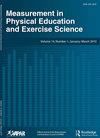Step Length, But Not Stepping Cadence, Strongly Predicts Physical Activity Intensity During Jogging and Running
IF 1.9
4区 教育学
Q2 EDUCATION & EDUCATIONAL RESEARCH
Measurement in Physical Education and Exercise Science
Pub Date : 2023-03-08
DOI:10.1080/1091367X.2023.2188118
引用次数: 0
Abstract
ABSTRACT Device-based measures often rely on the positive relationship between walking cadence and metabolic equivalents of task (METs) to estimate physical activity. It is unknown whether this relationship remains during jogging/running. The study purpose was to investigate the relationships between METs, cadence, and step length during walking and jogging/running. A treadmill protocol with 5 walking (3.2–6.4 km•hr−1) and 5 jogging/running stages (8.0–11.3 km•hr−1) was completed in 43 adults (23 ± 5 years, 19♀). Predictors of METs during walking and jogging/running were determined by generalized mixed modeling. The strongest prediction models for walking (R2 = 0.72, P < .001) and jogging/running (R2 = 0.75, P < .001) included cadence2, cadence, step length, age, and leg length (all, P < .001). Step length accounted for 49.1% and 78.3% of model variance during walking and jogging/running, respectively. METs are poorly estimated by cadence during jogging/running but step length reduces error. Strategies to measure step length in free-living settings could better predict physical activity intensity.步长,但不是步幅,有力地预测慢跑和跑步期间的体力活动强度
摘要基于设备的测量通常依赖于行走节奏和任务代谢当量(METs)之间的正相关关系来估计身体活动。目前尚不清楚这种关系在慢跑/跑步过程中是否仍然存在。研究目的是调查步行和慢跑/跑步过程中MET、节奏和步长之间的关系。有5次步行的跑步机方案(3.2–6.4 km•hr−1)和5个慢跑/跑步阶段(8.0–11.3 km•hr−1)在43名成年人(23名 ± 5. 年,19♀). 步行和慢跑/跑步期间MET的预测因子通过广义混合建模确定。最强的步行预测模型(R2 = 0.72,P < .001)和慢跑/跑步(R2 = 0.75,P < .001)包括节奏2、节奏、步长、年龄和腿长(均P < .001)。步行和慢跑/跑步时,步长分别占模型方差的49.1%和78.3%。在慢跑/跑步过程中,MET很难通过节奏来估计,但步长可以减少误差。在自由生活环境中测量步长的策略可以更好地预测身体活动强度。
本文章由计算机程序翻译,如有差异,请以英文原文为准。
求助全文
约1分钟内获得全文
求助全文
来源期刊

Measurement in Physical Education and Exercise Science
Medicine-Orthopedics and Sports Medicine
CiteScore
4.20
自引率
33.30%
发文量
24
期刊介绍:
The scope of Measurement in Physical Education and Exercise Science (MPEES) covers original measurement research, special issues, and tutorials within six substantive disciplines of physical education and exercise science. Six of the seven sections of MPEES define the substantive disciplines within the purview of the original research to be published in the journal: Exercise Science, Physical Activity, Physical Education Pedagogy, Psychology, Research Methodology and Statistics, and Sport Management and Administration. The seventh section of MPEES, Tutorial and Teacher’s Toolbox, serves to provide an outlet for review and/or didactic manuscripts to be published in the journal. Special issues provide an avenue for a coherent set of manuscripts (e.g., four to five) to collectively focus in-depth on an important and timely measurement-related issue within the scope of MPEES. The primary aim of MPEES is to publish high-impact manuscripts, most of which will focus on original research, that fit within the scope of the journal.
 求助内容:
求助内容: 应助结果提醒方式:
应助结果提醒方式:


